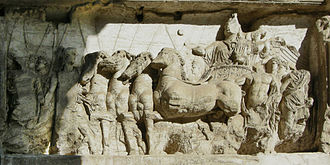On this episode of Arts and Facts Jo and Alisha discuss the similarities and differences between Greek and Roman gods, and how they inspired art.
Aphrodite (Greek): the
Goddess of love and beauty
 |
| Aphrodite (Venus de Milo) Between 130-100 BC Alexandros of Antioch |
The arms of this
sculpture were lost in its discovery and it is now permanently housed in the
Louvre museum. It was very rare that a woman should be portrayed unclothed near
that time period but it seems fitting in that she is Aphrodite and should be
both sensual and alluring yet classical and innocent. Both aspects are achieved
in this piece.
Venus (Roman): goddess
of both physical and intellectual love
 |
| Venus (Birth of Venus) 1486 Sandro Botticelli |
This painting of Venus
was commissioned by the Medici family who were great patrons of the arts during
which this was painted. Many different interpretations can be made of this
piece, some say it is a sort of wedding painting, plato argued that there is a
great link between physical and spiritual beauty within this piece. Here Venus
is portrayed as an Italian Renaissance ideal: red-haired, pale-skinned,
voluptuous. Botticelli has picked out highlights in her hair with gold leaf and
has emphasized the femininity of her body (long neck, curviness). very
classical looking, standing in contrapposto
Hermes (Greek):
Messenger of Zeus and god of travelers, flocks, houses and communities. He is
often portrayed carrying his heralds staff called a Kerykeion that ends
with two entwined snakes called a caduceus.
 |
| Hermes (lekythos) 480–470 b.c |
Here Hermes is wearing
his iconic winged shoes and Kerykeion.
Mercury (Roman): Similar
to Hermes, also carries a Kerykeion.
 |
| Mercury (the flying mercury) Giovanni da Bologna (1529-1608) |
Giovanni da Bologna's
famed Flying Mercury captures the Greek messenger of the gods speeding
through the skies. Mercury is depicted wearing a winged petasus on his
head and winged sandals which give him speed in flight
Zeus (Greek): god of the
skies, often shown holding one of his lightning bolts. Brother of Zeus
and Hades.
 |
| Zeus (George Washington), Horatio Greenough, 1840 |
Here, George Washington is symbolically portrayed as Zeus. He is holding the hilt of a sword out to the viewer representing him giving the power back to the American people.
Jupiter (Roman): Pretty
much Zeus with a Roman name

Jupiter (triumphator)
Athena (Greek): The
goddess of wisdom, courage, civilization, justice, law, inspiration, just
warfare, math, strength, strategy, arts and crafts and skill.
Minerva (Roman):
The goddess of music, poetry, commerce, crafts, weaving, magic, medicine,
wisdom. She is often portrayed with the symbol which is an owl.
 Statue of Athena. Vatican Museum, Rome.
Statue of Athena. Vatican Museum, Rome.
Hades (Greek): The god
of the underworld, where souls went after they died. He is the brother of Zeus
and Poseidon, all three the children of Jupiter.
Pluto (Roman): The roman
god of the underworld.
Poseidon (Greek): The
God of the Sea and horses. He is often shown carrying a trident. He is the
brother of Zeus and Hades.
Neptune (Roman): The
Roman god of the sea. He was the brother of Jupiter and Pluto, comparable to
Zeus and Hades.






















